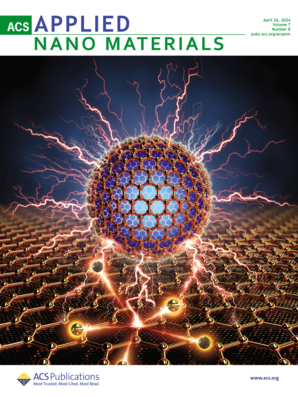原位生长 ZIF-67 纳米粒子的蚕丝纤维用于高效纳米流体离子传输膜
IF 5.5
2区 材料科学
Q2 MATERIALS SCIENCE, MULTIDISCIPLINARY
引用次数: 0
摘要
纳米流体系统因其独特的传输特性,在从海水淡化到传感器等众多应用领域发挥着至关重要的作用。在过去几年中,考虑到二维材料的简单结构,人们一直致力于设计用于离子传输的合成膜。然而,光刻技术等昂贵的制造方法以及放大困难、孔隙密度低、机械稳定性差和生物相容性差等缺点限制了它们的实际应用。在此,我们展示了一种具有三维(3D)互连纳米通道的可扩展分层多孔膜,该膜以丝纤维素(SF)纤维生物质为基础,通过在纤维表面原位生长沸石咪唑啉框架-67(ZIF-67)纳米颗粒来修饰纳米流体通道。根据密度泛函理论建模估算,厚度为 400 μm 的 ZIF-67/SF 膜是一个三维互连网络,具有较大的带正电表面积(54 m2 g-1),包含 1-5 nm 的孔隙。研究人员系统地探讨了通过 ZIF-67/SF 膜的纳米流体通道的表面电荷离子传输,并观察到在低浓度(≤10-3 M)的单价电解质(KCl、NaCl、NaOH 和 HCl)中,ZIF-67/SF 膜具有高于大容量离子传导的特性。此外,ZIF-67/SF 在高达 60 °C 的高温下也能保持稳定并充分发挥功能,而且在酸性和碱性条件下也能保持其结构和操作特性。本文章由计算机程序翻译,如有差异,请以英文原文为准。

Silk Fibroin Fibers with In Situ Growth of ZIF-67 Nanoparticles for Membranes with Highly Efficient Nanofluidic Ion Transport
Nanofluidic systems due to their unique transport properties play a crucial role in a lot of applications ranging from water desalination to sensors. Over the past few years, considering the simple structure of two-dimensional materials, significant efforts have been devoted to designing synthetic membranes for ion transport. However, expensive fabrication methods such as lithography techniques and some shortcomings such as scale-up difficulty, low pore density, poor mechanical stability, and biocompatibility limit their practical application. Herein, we demonstrate a scalable hierarchically porous membrane with three-dimensional (3D) interconnected nanochannels which is based on the silk fibroin (SF) fiber biomass and modifying the nanofluidic channels by in situ growth of zeolitic imidazolate framework-67 (ZIF-67) nanoparticles on the fiber surfaces. The ZIF-67/SF membrane with 400 μm thickness is a 3D interconnected network with a large positively charged surface area (54 m2 g–1) containing 1–5 nm pores estimated from density functional theory modeling. Surface-charge-governed ion transport through the nanofluidic channels of the ZIF-67/SF membrane is systematically explored, and characteristic higher-than-bulk ion conductivity was observed at low concentrations (≤10–3 M) of monovalent electrolytes (KCl, NaCl, NaOH, and HCl). Moreover, the ZIF-67/SF is stable and fully functional at elevated temperatures up to 60 °C and maintains its structural and operational properties under acidic and basic conditions.
求助全文
通过发布文献求助,成功后即可免费获取论文全文。
去求助
来源期刊

ACS Applied Nano Materials
Multiple-
CiteScore
8.30
自引率
3.40%
发文量
1601
期刊介绍:
ACS Applied Nano Materials is an interdisciplinary journal publishing original research covering all aspects of engineering, chemistry, physics and biology relevant to applications of nanomaterials. The journal is devoted to reports of new and original experimental and theoretical research of an applied nature that integrate knowledge in the areas of materials, engineering, physics, bioscience, and chemistry into important applications of nanomaterials.
 求助内容:
求助内容: 应助结果提醒方式:
应助结果提醒方式:


